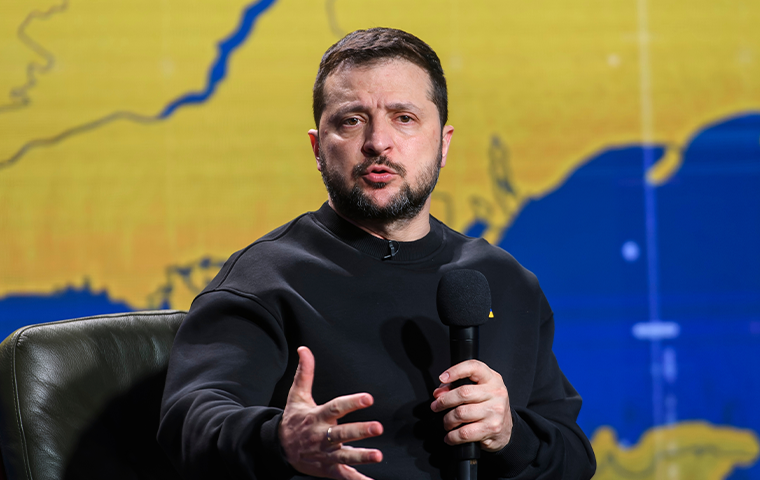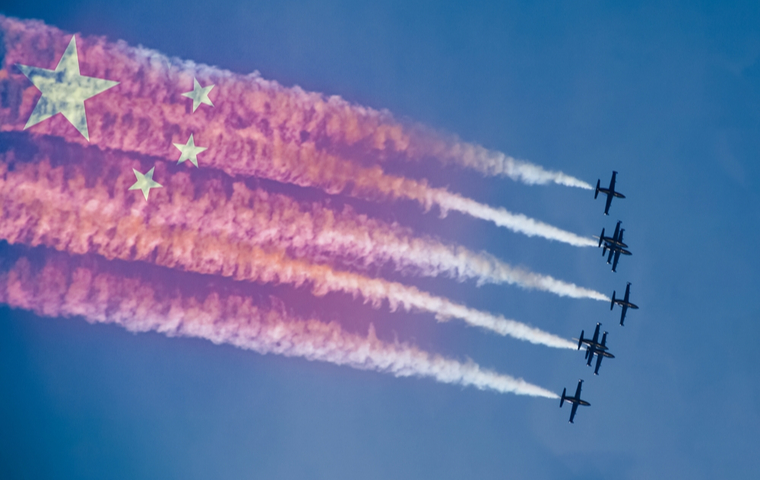Ukraine’s PR Strategy and “War Advertising Agencies”
Related Articles

With the Russian invasion of Ukraine in 2022, sales of my 2002 book, Documentary: War Advertising Agencies, suddenly surged. This book and the NHK Special program on which it was based, “Ethnic Cleansing: Inside the Yugoslavia Information Warfare,” depicted the “public relations (PR) information warfare” over the Bosnian conflict in the 1990s. A similar thing is happening again, but with a much deeper level of scale, technology, and sophistication.
There is also a crucial difference. Serbia, the target of PR information warfare in the Bosnian conflict, and its leader, Slobodan Milosevic, did not have nuclear weapons, but Russia and President Vladimir Putin do. This time, the outcome of the information warfare could lead to World War III. If that happens, it could also have a life-or-death impact even on the Japanese people as long as they are on this planet. In this sense, we would like to examine the latest case of President Volodymyr Zelensky’s PR strategy together with the information warfare in the Bosnian conflict.
Zelensky Has the Upper Hand in PR Information Warfare
What does the Bosnian conflict of the 1990s, as depicted in War Advertising Agencies, and the current invasion of Ukraine essentially have in common? It is the strategy in which the side with an overwhelming military disadvantage—Bosnia against Serbia and Ukraine against Russia—to appeal to world opinion and gain foreign support to counter their battlefield handicap. In both cases, the first aim is to influence and win over public opinion in the NATO member states, then bring in intervention or military support. As the conflict was about to erupt, then Bosnian President Alija Izetbegovic had already articulated to those around him he would “internationalize” the situation from a local ethnic conflict. In other words, the strategy was to “get the world involved.”
Generally, neither Bosnia nor Ukraine had their history and realities well understood by the rest of the world. For countries pulled into regional conflicts where their own public have little concern, the government needs to garner strong interest and convince voters to spend large amounts of tax money for support. The words of Foreign Minister Haris Silajdžić, who acted as the messenger of the Bosnian government, just like Zelensky does, express the view of the side waging the information warfare. “We have neither nuclear weapons nor oil. So, we must speak out. Just like the Bosnian proverb—only the crying baby gets the milk.” This can be said for today’s Ukraine.
Since the beginning of the war, Ukraine’s PR information warfare has gone through several phases. The initial and most vivid was the “We are here” video message that Zelensky and his aides shot outside the presidential palace on the second day of the invasion. Professor Yasuharu Ishizawa of Gakushuin Women’s College, who specializes in international communication, points out the following about this video strategy. “This is the symbol of the information warfare in Ukraine, where President Zelensky has become a ‘star.’ What differed from the pre-social media era was that it was a very modern way of showing that the senders themselves could post messages without using international media, and even if the enemy’s attack cuts off internet connections, they could still send messages through Starlink and other means. It was an extremely modern method.”
Why was such a brilliant PR information strategy possible so early on? Takeyuki Hasegawa, a researcher at the National Institute for Defense Studies of the Ministry of Defense, says, “Helped by information from NATO countries, the Zelensky administration must have expected the Russian attack to a considerable extent, including its methods, and decided in advance what to do in the event of such an attack.”
From early March 2022, a week after the war broke out, a new phase began, with Zelensky addressing parliaments and organizations around the world online. The speeches were skillfully tailored to each country’s situation and public sentiment, and country after country, the audience gave standing ovations to Zelensky on the screen. In June, he also appeared online at the Cannes Film Festival. In July, the global fashion magazine Vogue carried pictures of Zelensky and his wife hugging each other. The feature article is available online, so you can see for yourself. I guess few leaders in the world can do this.
Then, on December 22, 2022, Zelensky made a visit to the U.S. The highlight was his Congress speech with the spectacle scene of him presenting a Ukrainian flag to House Speaker Nancy Pelosi and Vice President and President of the Senate Kamala Harris, the two female politicians of the Democratic Party. The flag was signed by the frontline soldiers in Bakhmut, where Zelensky visited a day before flying to Washington. By using a prop, it had a stunning stage effect, perfect for a TV broadcast that craves visual impact. Zelensky’s U.S. trip was the start of his successive surprise visits to various other countries, which further boosted the PR effect. Finally, from May 2023, the visits extended outside the Western countries, into the Middle East and Asia (Hiroshima G7 Summit).
Many PR Firms Providing Free Engagement

Who is planning and executing these PR strategies for the Zelensky administration? Keio University Professor Koichiro Tanaka says he was surprised by the details of Zelensky’s speech at the Arab League Summit, which Zelensky attended just before the G7 Summit in May 2023, and was convinced professionals were behind this. “Putting aside whether he changed the minds of the heads of states, the language was calculated fully to strike the notes that would resonate with the Arab people. I felt certain it was written by the very best speechwriters targeting the Arab world.”
When I asked the executives of several PR firms, they said everyone knows that Western professionals are involved in the Zelensky administration’s PR warfare. There are also some international media reporting on this topic. One of the earliest is the March 17, 2022 article by the U.S. political news website Politico, titled, “The influencers behind the Ukrainian PR machine.” The leading British paper, the Guardian ran an article titled, “They’re lobbying for Ukraine pro bono—and making millions from arms firms” on March 1, 2023. Also, the NHK Special program, “Century of Turmoil: Part 6,” has interviewed one such PR firm (details in Japanese are available on the program’s website and on the online magazine Gendai Business). Also, checking the articles in PR journals, I also found reports of many such cases.
Summarizing all these, several points come into view.
Ukraine’s information warfare, which aims to thoroughly arouse global public opinion to “internationalize” the war, involves Western PR agencies, just like in the Bosnian conflict, but on an entirely different scale. In the Bosnian conflict, only few PR agencies were involved, like Ruder Finn of the U.S. with James Harff, the protagonist of the Document: War Advertising Agencies. But this time, all kinds of Western PR agencies, large and small, are scrambling to work for the Ukrainian government, ministries, parliamentary committees, and lawmakers. One rather unusual PR client is a company with Rinat Akhmetov as the president, who is the Ukrainian oligarch and owner of Azovstal Iron and Steel Works in Mariupol, which fell after a fierce battle. Several dozen or over a hundred such PR firms are said to be involved. Some are pro-Democratic Party, and some pro-Republican Party. There is even a case of a major PR agency that had been doing business with Russia until recently, switching to Ukraine.
Many such PR agencies receive no fees from the Ukrainian side and publicize they are contributing to the fight against Russia as volunteers. Because by doing so, they can enhance their own social reputation. Their PR warfare began even before the war broke out. One PR powerhouse had set up an office in Kyiv for some time, and still runs various campaigns for the Ukrainian government.
Given these circumstances, it is no surprise Zelensky’s speeches in various countries were meticulously customized, with fully calculated visual effects. It is a matter of course that the presidential couple appeared in the world’s leading fashion magazine, posing like Hollywood stars. Yet, no company has spoken to the media of the details like who in which company did what on each occasion. The agencies have confidentiality obligations with their clients, so it is tough to find out. Amidst such opaqueness, U.S. think tank researcher Ben Freeman, who wrote the Guardian article mentioned earlier, points out that while these PR agencies are providing services for free to Ukraine, they could also be taking in millions in fees from weapons manufacturers benefitting from boosting sales to Ukraine. Of course, this does not apply to all, and each agency has their own situation, but we should know that business is at the core of PR agencies.
Disturbing Statements from Ukrainian Senior Officials
Meanwhile, just like the Serb side in the Bosnian conflict, Russia’s PR information warfare has collapsed within the mainstream Western public opinion arena, shunned by all PR professionals.
How should we view the reality of such information warfare? Professor Ishizawa argues, “Of course, both sides are engaged in information warfare, including propaganda. However, it’s Russia’s information warfare as propaganda which generally attracts attention and is viewed negatively. Ukraine also distributes propaganda information besides Zelensky’s aggressive communication (PR information warfare). But since Ukraine is recognized as the “good” side within the global information arena, the world overlooks their propaganda.”
There is an Ukrainian comment that sticks to my mind—a statement by the head of the Main Intelligence Directorate of Ukraine’s Ministry of Defense, Kyrylo Budanov, in an interview with Yahoo News in May 2023. When asked if Ukraine was involved in the explosion in Moscow that killed the daughter of a Russian theorist, Alexander Dugin, Budanov answered, “Don’t continue with that topic. All I will comment on is that we’ve been killing Russians and we will keep killing Russians anywhere on the face of this world until the complete victory of Ukraine.” These words, sounding like psychological warfare to incite people’s fear, seem more like the way of their neighboring country, where the KGB once held massive power and its descendants are said to still hold key positions. There is no doubt Russia is to blame for what is happening on the battlefield and behind the lines. However, glimpses of such messages, including other cases, give you a daunting feel both sides are in the same club in terms of information warfare.
How Will the Media Face Information Warfare?
Lastly, as a person involved in journalism, I would like to share an impressive episode from the Hiroshima G7 Summit held in May 2023, which may provide some hint on what we should focus on when facing PR information warfare.
Arriving on surprise and after a crammed schedule in Hiroshima, Zelensky attended a press conference with domestic and international reporters. The remarkable thing about this press conference was that in the Q&A session, he answered all the questions on the spot, probably without the questions submitted in advance, much less any notes of prepared answers. I thought the question by the RCC Broadcasting Company, a TV station in Hiroshima, stood out. There were two questions. The first asked what he found most unforgettable at the Peace Memorial Museum. The second asked for his response to the voices of some in the bombed city of Hiroshima, who hoped there would be talk toward peace and not just talk about arms support, which seemed unbecoming for a summit in Hiroshima. It was something only a local TV station could ask, with its community-based coverage.
With his success in the PR information warfare, Zelensky is now a world star—someone you would hesitate to ask tough questions. Yet, he is the most powerful person in Ukraine and world’s leading figure who is invited to the G7 summit. A press conference for a person in such a position is not a fan meeting. If Ukraine shares the core values of democracy, such as the freedom of speech and freedom of the press, he will welcome words that strike home.
Zelensky also gave a great answer. To the first question, he said, “Historically, it wouldn’t be fair to compare,” and showed consideration for Hiroshima’s A-bomb survivors, then continued, “I’ll tell you sincerely. Pictures of ruined Hiroshima really reminded me of Bakhmut……Let me tell that we can see where we are now, this [Hiroshima] is a modern city today.” I guess he did not expect the second question. Yet, he said, “Donbas, where President Putin came, saying as if he is saving the lives of Russian-speaking people. This is how it looks like now. This is how Hiroshima used to look like.” In an answer alluding to his previous comment on Bakhmut that looked like an A-bombed city, he criticized Russia’s hypocrisy again.
The PR information warfare underway is not to be criticized. It is a crucial strategy for Ukraine’s survival. But neither should the media and journalism unconditionally assist it. Presenting diverse viewpoints from different perspectives will open the door to various truths for those receiving the information. Keeping the information space open and full of options is taken for granted in a democratic society. I strongly believe this will be an effective strategy against the malicious “information warfare” that may emerge on various occasions in the future.
This is a translation of the Japanese article published in vol. 80 (Jul./Aug. 2023) of the Gaiko (Diplomacy) magazine.
Toru Takagi is a Producer of the NHK World Department. After graduating from the University of Tokyo, he joined the Japan Broadcasting Corporation (NHK) in 1990. As a documentary director, he has made many programs including Minzoku joka: yugo johosen no uchimaku [Ethnic Cleansing: Inside the Yugoslavia Information Warfare]. He is the author of Dokyumento senso kokoku dairiten [Documentary: War Advertising Agencies], Daibutsuhakai [The Destruction of the Great Buddha], Kokusai media johosen [Global Media Information Warfare], and other books.




